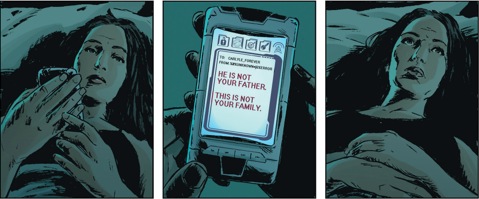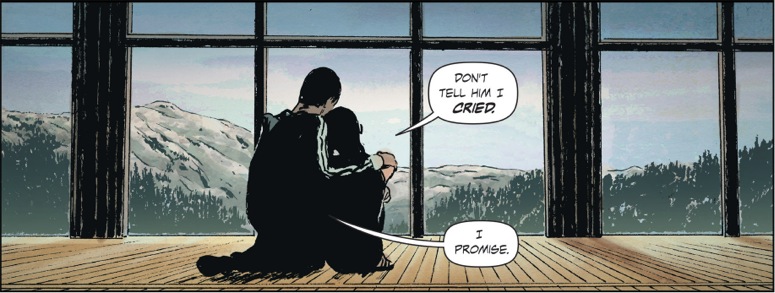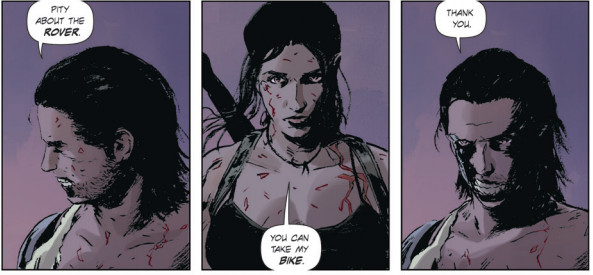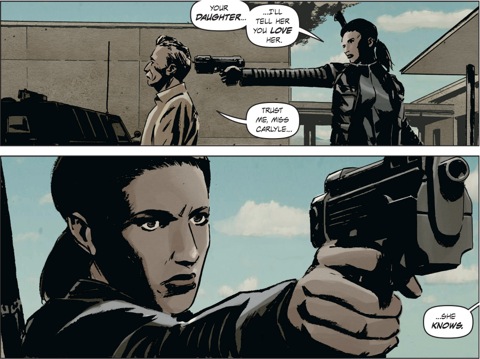Family Above All: The Unforgiving, Unrelenting Reality of “Lazarus”
We review the first nine issues of Rucka and Lark's Image title
This review first appeared on Multiversity Comics on September 2, 2014, but was written by me. It has been published here as well with their very kind permission.
The comparison has been made before, but more than ever, comics are like the music industry. Like with music, comics have grown increasingly niche oriented as the opportunities for those creating the art have increased, with smaller releases having greater reach than ever thanks to digital options and greater buying power of independent houses. Beyond that, success looks different, as with a bigger cut coming to the creator, it isn’t necessary to have such a big pie. So now, instead of aiming your work at all audiences and creating a homogenous mess, more and more creators are developing projects that wear their unique identities on their sleeves and build smaller, more passionate audiences in the process. In 2014, I can’t necessarily hand anyone a record by The Antlers, just like I couldn’t hand just anyone a copy of Greg Rucka and Michael Lark’s “Lazarus”, and that’s not a bad thing.
Case in point.
At the end of issue #6, Rucka answered reader questions and messages as he does at the end of every issue, except this time he had a special treat. Andrew J. Shaw is a noted letters column troll, perpetually squaring off against Robert Kirkman in “The Walking Dead” even though – near as I can tell – the guy hates the comic most months. He touches on other Image titles sometimes, and with issue #6, he unleashed his inner beast on “Lazarus”, lamenting the book for the perceived lack of plot while complimenting the scripting. You know what would take this book to the next level, Shaw suggested? An alien invasion.
Many writers would read that letter and say, “damn, I need to save this reader. What can I do?” Rucka? “Here’s your hat, don’t let the door hit you on the way out.” I actually started laughing after reading his response, because it was so perfect. Rucka was right – Shaw WAS missing the point with his suggestion. That’s not what “Lazarus” is. Readers today often want things now, and they want it big. They want twists and action scenes and BOLD, NEW DIRECTIONS. A lot of readers have been conditioned to expect these things from their stories, both in comics and outside of them, but that isn’t this book, so if you’re looking for that here, you aren’t going to find it.
So trust me when I say that “Lazarus” may genuinely not be for you, like it wasn’t for that reader.
But trust me at the same time when I say “Lazarus” is an absolutely tremendous book, and one that is hugely rewarding if you can appreciate the art of the slow burn. It’s a deep, introspective, powerful story, and you can find those shocking moments you desire, but it’s never going to be a book that is going to force feed you those things strictly because that’s what you are looking for. Hell, sometimes when you get the big, triumphant moments you’re looking for from the book, they’re the definition of a double edged sword, as you don’t really know whether this good thing really is a good thing.
It’s a black-and-white world crafted sheerly from grays. The world of “Lazarus” is one dominated entirely by family governments, and sometimes it’s hard to tell what the best position to be in is. Do you want to be lifted into a position of safety through servitude, as the second arc explored? Are you safer in a den of snakes than you are on the outside looking in? It’s a constant tug-of-war of moral ambiguity in the book not just for outsiders, but even insiders like series lead Forever Carlyle, a woman who endlessly supports her family even as they perpetually push her through a meat grinder with no comfort offered when she comes out on the other end.
Forever’s an endlessly fascinating character, as even though she’s effectively been programmed by her “family” to be emotionless and a weapon for their own disposal, she’s the heart and soul of the story. You see it in both big moments and small, as she bears the weight of her one secret and Lark devastates us with one look and small gesture as she contemplates its meaning.

Forever is a woman whose entire existence is defined by family. “Family above all”, as Rucka closes each letters column with, and none live that ideal more completely than Forever. Buried in her brutal, effective adult body is a little girl who – not to be schmaltzy and certainly not to mock her – truly just wants to be loved by her father, and no better section of the book depicted that than the opening pages during the “Lift” arc (issues #5 through #9). This arc showed Forever’s training in the hands of former Carlyle Family soldier Marisol, and you find a young girl who dotes to her father, even though he’s the type of man who refuses to see the little girl on her birthday because she’s unprepared to beat her mentor to death.
Even with his absence, or perhaps because of it, Forever lives a life dedicated to his name and his honor, and when faced with a moment of perceived weakness, the last thing she wants is for him to know of it.

A big part of our connection to the solemn Forever is the art. This may not be the showiest project Michael Lark has ever taken on – I mean, where the hell is Spider-Man? – but it’s certainly the finest work of his career, and it’s found in moments like the one above. Trust is a big word both inside the pages of this book and in the creation of it, and Rucka and Lark clearly trust each other to deliver this story in the way it has to be for maximum impact. In a dense, complicated world of deceit and intrigue, a stunning amount of this story is either delivered completely wordless, or in a fiercely economical fashion.
It’s because Lark can make a moment like the one above, or the one below, soar with just a few spoken words.

This scene you see above is probably my favorite sequence in any comic of the past couple years. I’ve went on and on about it, and I even ranted and raved at Lark and Rucka about it at NYCC 2013. It’s a simple three panel tier on a page containing 11 words, but it’s so much more than that. The man depicted in a state of great disrepair is Joacquim, the Lazarus (titular characters who are the protectors of the family they are affiliated with) of the Morray Family, and he feels a deep, affectionate connection with Forever, a woman who understands who and what he is. But when he perceives her seeing him in this scene as he sees himself deep down – as less than a man, more of a machine – he can’t face her.
Some writers would deliver this page with internal dialogue saying as much. Some would push the external dialogue to 11. Rucka knows less is more, and that Lark’s got this. Because of that, it becomes the special, heartbreaking moment it is.
The art throughout is phenomenal, and is a pitch perfect example of the power of visual storytelling. Lark with assists from Brian Level and colors from Santi Arcas is perpetually on point, nailing character moment after character moment and driving our connection to this world and these characters through the roof in the process. But that’s not all, as there are action sequences and big twists that they nail with equal aplomb (the big finish to “Lift” takes the cake there for me). Arcas accentuates everything perfectly, coloring to mood rather than reality, and really setting those feelings in us in a deeper way. He’s not a colorist I’d experienced before, but tonally and story-wise, he couldn’t be a better match to Lark’s work.
This book resonates as well as it does because of the deep character work, but it fascinates because of something else entirely: the world building. And by that, I mean very literally they are readjusting the world that we know, as you can see in this in-progress map series designer Eric Trautmann and Rucka are putting together. They aren’t half assing this in any way, using literally every square inch of the book to deliver weight and depth to the story. Don’t believe me? Check out this back cover from issue #6.

Are you wondering who the hell Carragher Holdings, LTD is? “Have I bought printer toner from them?” No. No you haven’t. “Lazarus” often features back covers with advertisements for the varying families of the world, with this one focusing on Oceania’s first family Carragher. It’s such incredibly subtle storytelling that I really, truly wonder how many people have actually noticed it. But there’s value there, as it helps build up one of the families that governs the world of “Lazarus” without needing to take story space away from other events transpiring within. The team – I presume Rucka and Trautmann, in particular – uses the letters column edges to help do this as well, often providing world timelines and family profiles that help educate the reader on the people that are about to get a hell of a lot more important in the upcoming “Conclave” arc.
These aren’t things many other books do, but in doing so, they give the reader significant added value for their experience, while enriching and expanding the world they’re building. I couldn’t love it more.
The most important element to their world building, however, took place in the second arc. The first arc was built around introducing Forever and her capability while also giving us an overview of the Family Carlyle and their reach and power. It was very good, but the second arc, “Lift”, did an incredible job of elevating the entire book to another level.
A big reason for that was giving us a view of the world from a different, less privileged perspective. The Barret family were “waste” (the lowest class in this world’s caste system) for the Carlyle Family, and in the face of disaster and a life of even greater obstacles, their family and their son’s girlfriend Casey Solomon go to Denver in the hopes of being “lifted” into a different class of citizen.
By that, I mean the Carlyle Family intermittently would put together comprehensive studies of its own citizens for the purpose of finding people amongst the waste that could be of value to them as “serfs.” Needless to say, in a world of destitute individuals, this is a huge event, as everyone shows up. I don’t want to spoil anything in it, but this arc – which balances the Barret family’s story, Forever’s childhood training and adult Forever’s attempts to take out a terrorist cell looking to make their presence felt at the Lift – is an absolute classic.
It’s hugely important to the scope and scale of the series, as it delves into the desperate lives of the people governed by this family and it explores who Forever really is and where she came from, but it also is just tremendously well-crafted and important to the success of the series.

A big part of that is giving the book more of a heart, and that’s through the Barret family, who often work as a counter-point to the conniving ways of the Carlyle family. The Barret family as a whole is just fantastic, and they live a life that’s truly “family above all.” They, namely the parents Joe and Bobbie, sacrifice themselves for their children, and they exist as an important contrast to the unforgiving nature of Carlyle family patriarch Malcolm. Beyond that, Michael Barret and Casey Solomon are incredibly appealing, inviting characters, with Casey being a spitfire – nobody talks to Forever like she does in the above panel – and Michael being a person with genuine goodness and talent in a world of opportunistic monsters. You can’t help but root for them, and in a book filled with people you’d like to see feel the sharpness of Forever’s blade, that is invaluable, and Rucka does an incredible job of giving us exactly what we need with them.
And that’s the story, isn’t it? “Lazarus” isn’t a book that I ever thought about wanting, but it delivers something that is truly needed in comics today. In an industry driven by the explicit – the apple butts and the cosmic punches and the alien invasions – Rucka and Lark find value in mining the implicit. The power of family. The slight turning of a face. The impact of a singular gesture.

It’s all there on the page, and it hits so much harder because they trust us to feel it the way the characters do.
Yes, “Lazarus” is a book that may not be for everyone. It’s unlike most anything you’ll find at your comic shop today, and we’re all the better for it. If you just look for plot in your comics, then you may want to look elsewhere. But if you’re looking for something with depth, with richness in storytelling, and with an identity entirely its own, Greg Rucka and Michael Lark may have built a world you’ll enjoy visiting.
Even as they’re tearing your heart out in the process.
